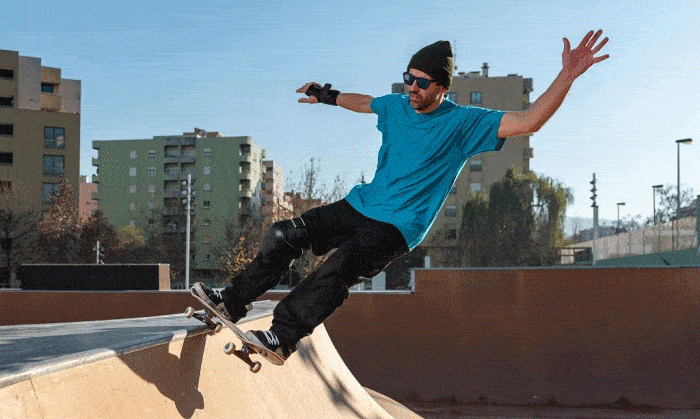No one settles with swinging back and forth on a skateboard bowl for hours because skateboarding is more than that. So, there’s no way you’d run out of styles and tricks.
Turning on a skateboard is common. But doing a 180° turn on a ramp is a bit more interesting. If you’re up for it, let me teach you how to rock and roll on a skateboard.
Table of Contents
What You Will Need
Like any skateboarding skill, nothing beats a complete preparation of equipment and riding space. Below is a detailed list of what we need.
1. Your skateboard
With skateboards varying in terms of the user’s age and skill, it’s necessary to prepare a rock and roll skateboard. Here are the features you need to check.
- Wheels: the first aspect you need to check on this component is its hardness. Rollers for tricks have a hardness level of 99A and 100A. They also need to have enough rebound and a size range of around 52mm to 54mm. If you want to be more specific about the shape, go for the conical-shaped wheels with narrow contact patches.
- Deck: you will need a rock and roll skateboard deck to perform this trick safely. With that, look for a width of around 7.75″ to 8.25″. These figures are enough to give your feet ample stepping space. And since you’re dealing with a dynamic skateboarding arena, you might as well consider using a durable deck made with maple wood.
2. Skating venue
The first thing you need to secure when searching for skateboarding locations for this skill is a ramp. And to discuss the skateboard rock and roll trick, let’s settle with a quarter pipe ramp.
You can find it in skate parks, or others create their own within their lawn. However, it costs enough time to do the latter. But as long as your ramp is smooth, has a coping, is not too steep, and is not crowded, it can be a good practice location for you.
3. Skating attire
You won’t be doing skate rock and roll on a plane surface. You will be challenging your core to balance with your body tilted while going up the ramp. That means you have to wear appropriate protection gear.
Consider wearing grippy sneakers. These will help you complete the turn on the ramp without falling on the skateboard.
You should wear pieces of safety equipment. These include a pair of elbow pads, wrist guards, and knee pads. They’ll help you contain impact should you fall on your skateboard.
Ways to Rock and Roll on a Skateboard
Learning how to rock and roll skateboard is a quick and easy trick to do. But to make things more precise, take note of the following steps.
Step 1: Footing
In this tutorial, we’ll master two footing positions.
The first is pushing. To do this, place your dominant foot on the skateboard with its tip right on the front truck bolts. Your back foot will add force to the board by kicking it to the back.
The second position is the approach. As soon as your skateboard obtains enough momentum towards the ramp, you have to rotate your front foot from the balls. It’ll put it in a perpendicular position to the deck. Follow with your back foot mirroring your front foot and near the board’s tail.
Step 2: Gaining momentum
Now that you know the two positions we need to execute, it’s time that we approach the quarterpipe. Start by pointing the nose of your skateboard a few meters away from the lowest part of the transition.
Be sure you’re aiming straight and center to keep you from sliding off the ramp. Using the first footing position, push on your skateboard to obtain some speed.
Step 3: Approaching the ramp
As soon as your skateboard gains momentum enough to reach the ramp’s coping, move your feet to the second footing. Do it smoothly to maintain your balance. Bend your knees once the front wheels make it to the bottom part of the transition. It’ll add force to the trucks while going up the ramp.
Pro tip: Always keep your core centered and through the board no matter how tilted your board and body are.
Step 4: Getting over the coping
Your skateboard reduces some speed the moment it goes up the ramp. Take note that only your front truck has to go over the coping. So, once the front wheels get near the topmost portion of the transition, release some pressure on the front truck to send it over the coping.
Next, push it back down with your front foot. It’ll shift your weight to the front truck as you prepare to slide down.
Step 5: Rotating the body
For purposes of a better discussion, let’s assume you’re a regular skateboarder using the left foot as the front.
Press your front truck with your left or dominant foot as your rear truck departs from the surface of the transition.
Next, rotate your shoulders to the right as you press your rear truck. As soon as the front wheels detach from the ramp’s top surface, guide it with your front foot to complete a 180° rotation. By then, your left foot remains front.
Step 6: Sliding down
After completing the rotation, maintain your balance by bending your knees and spreading your arms. Keep your core centered as you slide down the ramp.
Make sure you remain in a straight direction to get down the transition smoothly. As soon as you reach the end of the ramp, begin to straighten your legs back.
Conclusion
Skateboarding is not only about thrill and challenges. It also deals with creativity, which makes the rider improve. And while there are numerous tricks you can do with skateboards and skating parks, there’s no way you’d run out of styles.
Now that you know how to rock and roll on a skateboard, riding ramps are no longer plain or boring. Always remember the things I have shared with you to make you feel more confident.
Did you like this tutorial? Leave your thoughts in the comments section.

Hi, I am Charles Harris. I opened this site to write as much as I can about my biggest passion – skateboarding!
I started as a clumsy yet passionate rookie 10 years ago to now a still passionate yet much better skateboarder! But I have to tell you, the whole journey has always been fun and rewarding, indeed not without hardship.




